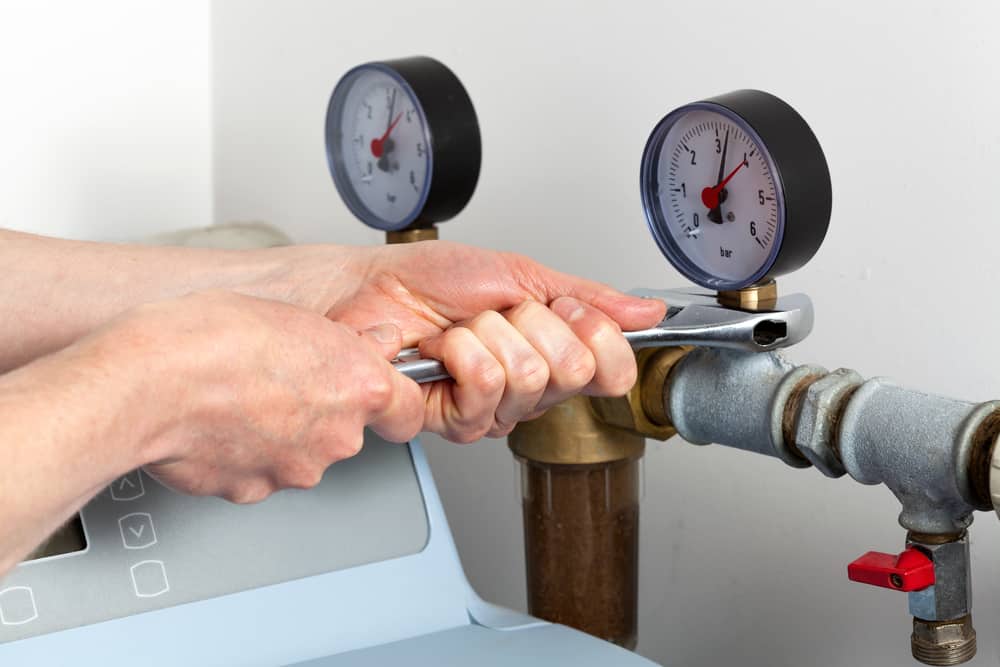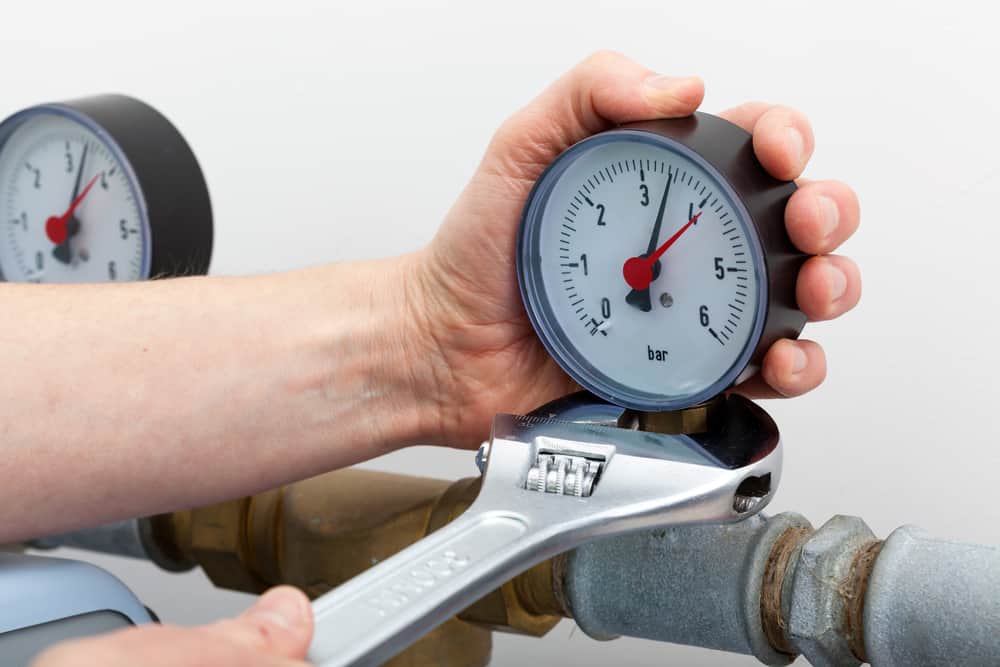We like to share product recommendations with you and hope you like them! Just to make you aware Water Filter Data may collect a small share of sales or other compensation from the links on this page.
Having a water softener problem can reduce your water quality and shorten the system’s lifespan. This is why you need to do regular maintenance checks and act quickly whenever you notice something strange with your water softener.
Thankfully its problems are easy to solve. All you need is your sheer will and this guide to make sure that you can tackle any problem that might come your way. The solutions are easy to follow and once you read them you will have no problem implementing them at home.
Easy solutions for easy problems

These are the things that might have slipped by you, so it pays off to check them out.
1. Does it Have Electricity?
Sometimes, the problem is embarrassingly simple, but you’d be surprised how often this happens. Check to make sure your water softener is plugged in and that the outlet is hot. Check to see if the breaker has been thrown.
2. Check the Bypass Switch
Every water softener has a special valve that directs water into or away from it. If one of the handles is turned the wrong way, the water you’re using is not being filtered by the softener. Close the special valve.
3. When Does it Regenerate?
If the timer is not set correctly or failed, your softener could be running at the wrong time of day, or it might not be regenerating at all. A single-tank softener should be set to regenerate at night, and water pressure could vary based on a lot of factors in your area.
If you find the water softener is not working when you peak, you need to change the filter. Kinetico dual-tank softeners still provide soft water while regenerating. Test your timer by setting it for a daily regeneration cycle, then listen to hear if the unit comes on overnight.
4. Is There Enough Salt?
Maintaining an optimal salt level is the best “fix” here. Generally speaking, the salt level should be 3 or 4 inches above the water level. If salt gets too low, your water softener won’t work properly. Using the wrong type of salt can cause water softener guides, bridges (crusty salt buildup) above the water level in the tank, preventing it from treating water properly.
To remove a salt bridge, tap on it (not on the tank) with something hard and blunt. If your water tastes salty, the system is using too much salt, or there may be a clog in the drain hose that doesn’t allow all the brine water to be properly flushed away.
5. Is There Enough (Or Too Much) Water in the Tank?
Water softener systems must flow into the brine/salt tank and then back out. The water level is regulated by a float switch. If it malfunctions, the tank may overfill and fail to empty. With proper function, you should not see water in the tank.
You’ll have to empty it by hand, then clean it. If the float valve is working properly, the problem may be a clog in the drain control or tubing, or there could be a problem with the timer. Water Softener If water is not entering the tank, perhaps the float switch is stuck or there is a clog in its tubing.
If cleaning doesn’t fix the problem, you will need to replace it.
6. Has the Resin Depleted?
Over time, the resin in the tank becomes depleted, reducing its effectiveness in removing unwanted chemicals from the water. Yes, the regeneration process “revives” the resin beads so they can continue cleaning more water, but older softeners have less life remaining. When the resin wears out after several years of hard water running through the tank, a new water softener is needed.
7. Maybe the Motor is Faulty
The water softener will not be able to soften the water if the motor is not running fast enough or not running at all.
Common Water Softener Problems
And if the first steps didn’t help you might probably want to follow the following steps to solve the more specific problems you might be having.
1. Water Softener Problems Water In Salt Tank
Perhaps the primary concern hard water users are facing is a salt tank full of water. This usually happens due to a lack of overflow or clogging, but can be caused by multiple factors. Identifying the right reason why there’s water in the salt tank can help you troubleshoot the unit correctly.
Here are the most common reasons why water could gather in the salt tank:
- The water softener is too old
These systems have a life expectancy of about eight years, after which they start to degrade quickly.
If your system is old or if you don’t know how old it is, inspect its components for wear and tear damage, such as cracks in the tank and o-ring damages.
- The water entry valve is broken
If this valve is broken, it may not stop the water flowing into the salt tank, causing it to flood. Merely replace the lid to solve the issue and soften your water.
- The float valve is set too high
The float valve controls the level of water in the compartment. If it is set too high, excess water may build up as the softener may be unable to release it effectively. Set the float valve lower to fix it.
2. Water Softener Problems Salt Bridges
Water softeners are designed to prevent minerals from scaling on your pipes and fixtures, but they’re still subject to salt which is still a mineral and will still scale inside the tank and within the system’s lines, so you’ve got to decide what fits your unit most. This build-up can sometimes form salt bridges at the base of the tank that prevents water softening systems from regenerating.
Salt bridges are easy to identify when they break a system. Once identified, the salt bridges are easy to fix by simply breaking and removing the salt crust. Also, make sure to clean any salt build-up around the edges of the water softener.
3. Water Softener Makes Water Brown
Most of us will recognize the brown water in the tap as a sign that the water is contaminated. However, a water softener may be installed at home in which it hides damages and may occasionally cause brown water to flow out of the tap. For your information, there is a remote chance to have brown water because of our water softener. This is likely caused by worn-out plumbing or high amounts of dirt and sediment in the water feed.
Therefore the accumulation of bacteria in your water softener may also be a cause of brown undrinkable water. To exclude this possibility, sterilize your system with chlorine or hydrogen peroxide. Put two cups of sterilizer into the brine tank, run two or three regeneration cycles, then flush your pumping. If the problem persists, call in a plumber to inspect your system for leaks or contact your water supplier to see if there are any reported faults.
4. Water Softener Doesn’t Use Salt
If you notice that your salt level in your water softener stays the same over time, it means that no more salt is used in the ion exchange process. This makes for a pointless system because ion exchange is vital in the softening of hard water. An easy fix for a salt-free water softener is to flush the system. Flush the salt-free water softener by using 4 to 6 gallons of water in a 5-gallon bucket. Stir the bucket with the hose’s spray nozzle open for several minutes. Then turn on the hose faucet and let run until the bucket is empty.
5. Brine Tank Water Too Low
We already described the main causes of a too-full brine tank. However, what to do when the brine tank is low on water?
Many people are wondering why there is no water in their brine tank, but know that this is normal and an indicator that your system works properly. Unless the salt level in the tank drops considerably, to around ½ of the volume of the tank, there is little chance to spot water in there.
6. Water Softener Problems Resin Beads
Soapstone is a water softener that uses salt-free mineral filtration to soften water and reduce hard water problems. It lasts longer than resin systems, but less than salt.
Another indicator the resin beads are not working is by noticing floating particles in the softened water. Although this could be an annoying issue, the solution is rather simple.
Clean or replace the resin beads following the instructions and you’ll notice this issue is usually easy to fix without spending a lot of money.
7. Water Softener Not Softening
Perhaps the most annoying of all water softener problems is noticing that your system is not actually softening the water. Perhaps the most annoying of all water softener problems is noticing that your system is not actually improving the water.
For instance, a water softener system bypass switch might be turned off, in which case water is not flowing through the system at all. Your soft water demand may also exceed your system’s capacity. In this case, resin beads may not fully regenerate between cycles and hard water may build up.
Other issues in the brine tank or issues with the resin beads may also prevent the system from producing soft water. If it is determined that the system is draining but not filling up, then troubleshooting will be needed to check if your magna valves are leaking or your grid might be clogged.
If you need more soft water than the system can produce, you can increase your system’s capacity slightly with more salt and extended regeneration cycles.
8. Water Softener Causing Low Water Pressure

A water softener may cause low water pressure issues for homes with the following problems.
- The system is too small
Improper sizing of the system can cause low water pressure. When sizing your water softener, check both the inlet and output pressure the system can handle.
- Sediment build-up
Clogging in any part of the system may reduce the water pressure, which can result in scaling or sediment buildup within the pipes.
If you suspect a blockage, check the piping and rest of the system to identify it, then remove the blockage.
- Resin clogs
Just like sediment build-up, resin beads flushed out of the water softener can clog the pipes and cause water pressure loss.
To fix the issue, replace the resin beads and flush the entire system to remove any beads blocked into it.
- The iron build-up in the resin tank
Another common issue is the iron build-up in the resin tank which can reduce water pressure significantly.
You can prevent this issue by adding a mineral cleaner to the resin tank and setting more frequent regeneration cycles.
9. Water Softener Problems Salty Taste
Water hardness turns into an unpleasant experience, especially if you’ll have to deal with the stomachache aftermath. The water softener is a great choice because it won’t make your water taste salty.
If the water in your home is hard, you may need a water softener, but if it isn’t, that’s a sign there is something wrong with your system. Oftentimes, you might be simply using too much salt. The drain hose could also be clogged, in which case brine will not be flushed during the regenerating cycles.
If you notice the water is suddenly salty, check the hose and unclog it if necessary. If the hose is not clogged, try to reduce the salt dose you use in your water softener.
10. Water Softener Motor Failure
Be aware that these water softeners run on electricity and are powered by motors. If the system simply dies, it’s most likely because something happened to the motor. Before concluding though, check the cables and make sure they are not damaged.
If they are fine and the water softener still doesn’t start, there is little you can do. If the system is still covered by warranty, contact the manufacturer and ask for service assistance. Water Softeners can be faulty and stop working at times. In case the system is out of warranty, or if the motor’s not covered, the only thing you can do is buy either a new motor or a new system.
11. Water Softener Will Not Regenerate
If the proper maintenance isn’t carried out on your system, your water softener could fail. The correct functioning of the system depends on how well you maintain the device. Water softeners need to run their regeneration cycles to work properly, but sometimes they may fail to do this for several reasons.
The most common cause of water softener problems is a faulty regeneration timer. Without the timer, the machine will never know that it must run its cycle. To check if this is indeed the issue, set the regeneration timer to daily and check if you hear specific sounds when it has run its cycle.
If you don’t hear these sounds, it means your timer is broken and you need a replacement. If the softener has been clogged, the specific cycle may make a noise but you might notice the water is saltier. If this happens, check that the tubes flush water to ensure proper functioning.
12. Water Softener Is Leaking
Another common water softener problem is noticing leakage in tanks, lines, and other components. Once detected, you’ll have to fix or replace the component. Luckily, most leaks happen due to errors in the installation, so they are quite easy to fix.
If you do have to replace parts though, remember to follow the manufacturer’s instructions to avoid bringing other damages to the system.
13. Water Softener Makes Funny Noises
The water softeners are a thing you should know right from the start. Perhaps you’ll hear it during the regeneration cycle, but it must still be relatively silent, and the sounds must be smooth, like those of a running engine.
If the system makes funny noises or it’s incredibly loud, that’s a sign something is wrong with the water softener, like:
- Clogged valves or water lines.
- Broken air valves.
- Worn-out timer.
14. Water Softener Keeps Running
The water softener keeps running over and over again. There are a few reasons why this might happen. The most common reason is the inability to draw brine from the tank, which is often caused by salt bridges or sediment buildup in the water lines.
Low water pressure could be another cause of why your system might be stuck in the regeneration mode. Check your settings and the switches. Otherwise, there may be a broken switch keeping a part of your system stuck in the regeneration cycle.
15. Operation Error
Water softeners, like any other systems that rely on manual settings and inputs, are subject to operation errors. If your system is particularly complicated and you don’t have the technical knowledge to set it properly, our designer will give you the water conditioning solution you need. Before operating the system, therefore, make sure you can use your appliance in full confidence and that you can troubleshoot it if user errors occur.
Otherwise, ask a professional to install and set up your water softener.
Five Steps for Keeping Your Softener Healthy
- The water softeners use pure salt with iron remover and standard rock salt can cause inches of sediment to build up in the brine tank and the sediment can clog the injector and the softener’s control valve, we’re using pure salt with iron remover.
- Don’t add salt until almost all the salt in the tank is used up. Then refill the tank no more than two-thirds full to reduce soap scum.
- Use Iron-Out once a year on the softener tank, resin bed, and parts in the control valve to clean the system.
- Clean the brine tank once a year even if it contains only pure salt. Contaminants cause clogs in the softener.
- Make sure the water softener drain line isn’t pushed down into a floor drain. The end of the drain line should be above the grate of the drain to prevent accidental siphoning of sewage into the softener.
Last Words
A faulty water softener will result in you not being able to have access to soft water, and it may even reduce the quality of water you’re using. These machines come with issues, but we are here to help you troubleshoot these problems quickly and easily.
Luckily, the most common water softener problems are easy to identify and troubleshoot.

Wayne is a water quality expert – The founder of Water Filter Data. He has a degree in microbiology and his field of expertise is drinking water. His goal is to allow for clean and healthy water for as many people as possible.



